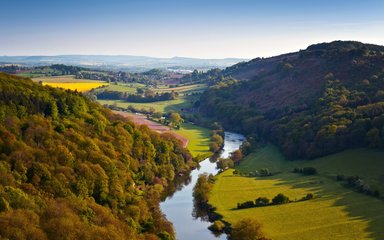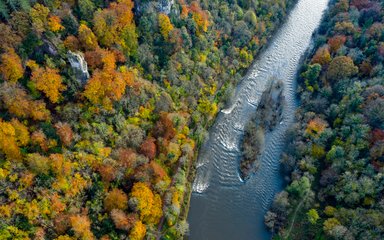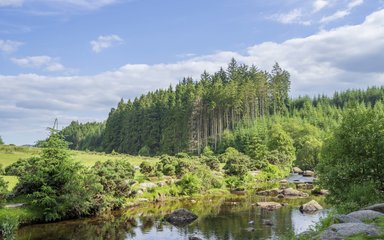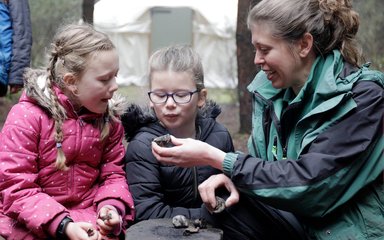
Trees are our ally
Trees capture and store carbon but that is only part of the story.
At Forestry England we are committed to achieving net zero greenhouse gas emissions by 2030 and removing our dependence on fossil fuels. Work is already underway across our estate, focusing on renewable energy and reducing vehicle emissions, so that we can meet our goal, but this is something that you as a school can do too.
Ask your students to complete the following activities:
Work through these activities with your students to help them understand more about how we can all play our part in cutting emissions. We recommend allocating a minimum of 30 minutes per activity.
1. Carbon capture
Calculate how much carbon is being stored in the trees on your school grounds.
2. Reducing emissions
Find out about and discuss some of the work that we are doing as an organisation to reach our target of net zero carbon by 2030.
3. School audit
Carry out an audit of your school to investigate where you can reduce carbon emissions.
4. Your pledge
Let us know what you are going to commit to doing as a school to reduce your carbon emissions.
Target age: KS3
Curriculum links:
- Chemistry - The production of carbon dioxide by human activity and the impact on climate.
- Geography - Understand how human and physical processes interact to influence, and change landscapes, environments and the climate; and how human activity relies on effective functioning of natural systems.
Prior learning:
View Forestry England climate change video
Read UK Climate Change Committee factsheet
These resources were produced with Geography South West
1. Carbon capture
How does it work?
Trees reduce the impact of climate change by absorbing carbon dioxide as they grow and storing it as carbon in wood. Through carefully selecting appropriate tree species for the soil and climate condition we can lock up more carbon efficiently. Healthy growing trees and a well managed forest are more efficient at capturing carbon.
Your task
Use the carbon capture activity sheet to help you calculate how much carbon the trees on or near your school site are storing. When you’ve made your calculation(s), to get an idea of how much carbon this actually is, have a look at the table below which shows some examples of how much carbon is produced during certain activities.
| Carbon footprint analysis | |||
|---|---|---|---|
| Boiling the kettle | 5g | Return train journey from London to Glasgow | 64kg |
| Using a laptop for 1 hour | 20g | London to Madrid return flight | 195kg per passenger |
| Filling up a car tank with petrol | 173g | Production of a new laptop | 326kg |
| Average UK home weekly electricity | 24kg | Production of a new Range Rover | 25tonnes |

2. Reducing emissions
At Forestry England we are committed to achieving net zero greenhouse gas emissions by 2030.
We're at the start of a journey but have already made great progress in removing our dependence on fossil fuels. We have carried out audits of our buildings to improve energy efficiency, introduced electric vehicles to our fleet and are planning clean energy projects.
We will always manage the nation's forests sustainably and plant more trees. It is our responsibility to ensure that forests are fit for the future and continue to provide timber. Timber is a renewable resource and helps tackle the climate crisis by locking up carbon from the atmosphere.
| Ways that Forestry England are reducing carbon emissions | |
|---|---|
| Throughout Forestry England | Our corporate waterproof clothing manufacturer are the first UK members of the Sustainable Action Plan |
| Dalby Forest, North Yorkshire | Now using electric strimmer, hedge cutter and leaf blower |
| Hardknott Forest, Lake District | Trialing alternatives to plastic tree guards such as sheep's wool and nut oil materials |
| Peil Wyke Office, North Cumbria | Swapped from using laminated signs to using waterproof paper which can be recycled after use |
| Bedgebury National Pinetum and forest, Kent | Coppiced chestnut grown on site is chipped and used as fuel for the visitor centre's hot water and heating |
| Whinlatter Forest, Cumbria | Installation of a hydroturbine system to generate electricity for Whinlatter Forest |
Below is one example where we have kept sustainability at the forefront of our designs for new recreational facilities at our Delamere forest centre.
Your task
Discuss what you have learned about carbon capture and reducing emissions.
If you were leading Forestry England to become less dependent on fossil fuels, what would you advise? How would you keep up with the latest technology and prioritise which ones to trial?
3. School audit
Your task
Complete a school audit to reduce your school's carbon footprint.
Walk around your school and have a look at the various components to see if they are as efficient as they could be. Are there any improvements that could be made to reduce carbon emissions? Do you feel the school could look for ways to offset its carbon emissions?
Once you have completed your audit, write a letter or make a short film for your headteacher or the school's decision makers explaining what you think should be done to reduce your carbon emissions and why. You might need to do some research on what elements would be the most cost effective or have the biggest impact. Don't forget to consider any negative outcomes that might come from your ideas and suggest some mitigation tactics.
Download the activity sheet to help you know what to look for and record your findings on the back.
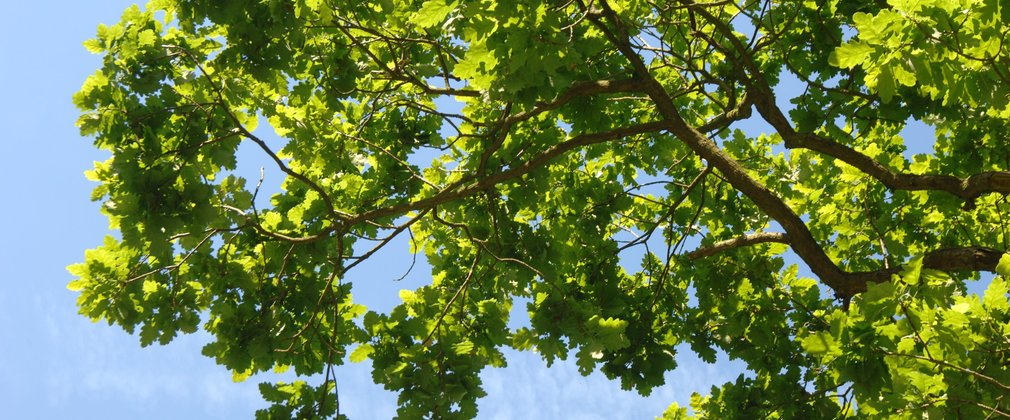
4. Your pledge to combat climate change
As a school we challenge you to make a commitment to reduce your carbon emissions, however big or small. If we all make small changes to our everyday lives it will start to make an impact on the extent of climate change.
Your task
Taking into account all that you have learned so far, have a discussion to decide upon what action you are going to take to reduce your school’s carbon footprint. In your audit you probably came up with lots of things that you could do but a lot of them might cost a lot of money. Maybe fundraising could be a part of what you decide? Perhaps you could recycle more, plant some trees or make it easier to cycle to school, it really is up to you.
Make sure your pledge is achievable and determine a way for you to measure its success. We would love to hear about your plans.
Share your pledges with us at learning.england@forestryengland.uk.

